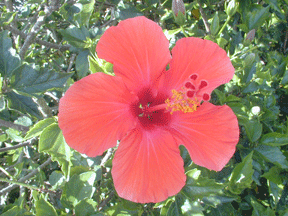Skip to content
Hibiscus rosa-sinensis

PLANT NAME: Hibiscus rosa-sinensis L.
COMMON NAMES: Aloalo [Hawai’i]; red hibiscus; china rose [English]; da hong hua (“big red flower”) [China];’aute samoa [Samoa]; fu sang; gumamela [Philippines]; Hawaiian hibiscus [Australia]; japä [India]; japa puspi [Nepal]; japapushpam [India]; papo [Panama]; pejo [Colombia]; shoeflower [Jamaica].
FAMILY: Malvaceae.
RANGE: Native to China / India, but globally pandemic in temperate and tropical areas. The Polynesians carried Hibiscus rosa-sinensis across the Pacific, as far east as the Marqueses Islands. Some say that it is not native to anywhere and is a man-made hybrid. In Hawai’i some of the flowers may have crossed with our native species.
USE AS FOOD: In China the Flower petals are added to baked goods, with sugar and lemon. Flower petals are used as a condiment with salads. The flowers are pickled. The leaves are sometimes used as a potherb. The flowers can be boiled, sweetened, and chilled for a summer drink [India].
TOXICITY: The flowers are not teratologic (do not cause birth defects) in rats at clinical doses [Nath 1992].
CAUTIONS AND CONTRAINDICATIONS: Occupational skin symptoms are suspected for Hibiscus rosa-sinensis.
Not in pregnancy [Brinker 2001].
POSSIBLE DRUG INTERACTIONS: Possible hypokalemia due to diuretic action of some Hibiscus spp. (speculative). Following this line of thought, possible interactions include: NSAIDS (toxicity), muscle relaxants (potentiation), antidiabetic medications (antagonism), lithium therapy (potentiation), corticosteroids (hypokalemia), diuretics (potentiation), antihypertensives (potentiation), sympathomimetics (antagonism). All of this is speculative.
NOTES ‘N QUOTES
-
The flowers are hermaphroditic (are both male and female).
-
Aloalo is one of our best local plants used topically for boils. It also is useful to break up sticky lung phlegm. It should be used fresh.



